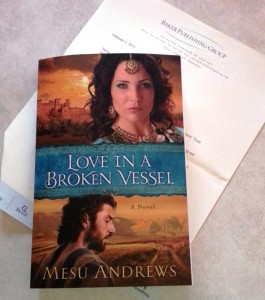 Laptop to Bookstore – Journey of a Manuscript
Laptop to Bookstore – Journey of a Manuscript
When I signed my first contract in November 2008, I had no idea what process lay ahead in the coming months (and years) to transform a manuscript from my laptop into a book on store shelves. I’ve been told all publishing houses vary in specific processes, but here’s how the fabulous folks at Revell have worked with me…
Rough Draft Deadline
My senior editor sees the first rough draft on a date specified in my original contract. My editor—Vicki—doesn’t want to see any part of the rough draft before she reads the whole thing, all at once, with fresh eyes. Her task is to edit for overall impression, character development, story pacing (does the story lag at any point, start where it should, tie up all the loose ends, etc.). She does a few “line edits,” things like misspellings, blatant grammar faux pas, or over-used words and phrases.
I may wait two to four weeks for results of this first edit, depending on Vicki’s workload and/or the amount of “help” my rough draft needs. It’s a crucial time of big-picture revamping. She returns the manuscript with her edits highlighted in “track changes” (a MS Word feature that Macintosh shares) and gives me a new deadline to return my revisions.
Revisions Deadline
When I receive my first “echo” from Vicki’s brain, I review her comments, her ideas, her critique of my story. It’s a time for much prayer and “putting on my big girl panties”—listening with an attitude of teamwork to make the manuscript better. Her ideas often make characters and concepts stronger and challenge weak areas that may need to be changed drastically or cut altogether. I must “dig deeper” into my emotion, God’s Word, the writing craft—find something that will meet not only her expectations but the expectations of the readers she knows better than I do. Her experience matters! At the same time, however, I must prayerfully consider things the Lord has etched on my heart—what’s crucial to the integrity of His story? And then I chat about how to reconcile her wisdom and experience with my passion and good intentions—and we let the Spirit lead us to a win-win solution. Every. Time.
My revisions may require another month-long process. Sometimes adding a character, changing a character’s age, combing through the entire manuscript line-by-line, word-by-word. I return the revisions and pray! If more revisions are necessary, we talk again and revise again. Vicki is both my greatest cheerleader and toughest critic—and she fulfills both roles with grace. When she deems the ms (manuscript) satisfactory, it goes to the project manager (or copy editor).
Copy Edit Deadline
When you think of a copy editor, think: grammar-nazi. Now, my copy editor happens to be the kindest grammar-nazi in the world, offering her edits and suggestions on a pillow of encouragement. She finds every misspelled word, misplaced comma, wrongly-hyphenated word, and every dangling part-of-speech you can imagine. She’s also commissioned to find inconsistencies in the ms. Does the heroine have blue eyes in chapter one and brown eyes in chapter twenty? Does the villain kill the hero with poison—but then stab the hero two pages later? This may sound silly, but when you write 400+ page novels, you’d be surprised how many changes occur, and how many inconsistencies arise from those early revisions! My copy editor (Jessica) gives me another deadline to “fix” the ms, and I return another revision to her.
To The Galleys!
When Jessica is satisfied that all her copy edits have been made, she returns the ms to me again in the form of galleys. These come in electronic form but are formatted with all the text that the real book will include. Page numbers, copyright information, chapter numbers and Scripture headings—it’s all there, and it looks so official! If I discover a major error in research (as I did in Love Amid the Ashes—when Jill Eileen Smith broke the news that silk didn’t arrive in Israel until the time of Solomon—almost 1000 years after my story! Eee-gad!), this is my last opportunity to make substantial changes to the ms.
The galleys are combed with prayer, a final reading and editing to ask the Lord what more—or less—He wants spoken through these words, these characters, these Scriptures. And then it’s back to Jessica for the final copy edit.
Proof Pages
The UPS man delivers my proof pages in a wonderfully sturdy brown box. I carefully slice open the packing tape, and there before me lies the typeset pages of my new baby—printed on computer paper, no cover, but still glorious! By this time, I’ve read these words too many times to find small errors. My critique group has begun dodging my phone calls, and my husband locks himself in the bathroom if he sees me coming at him with this ms in hand. It’s time to involve other readers. I need someone who:
- Lives close enough to physically read the typeset pages.
- Is a stickler for details.
- Isn’t afraid to be honest with me.
The galleys are usually the most fun to read because they have few typos or mistakes. It’s the final read before printing in book form.
If we find errors on proof pages, I either fax the page or email a description to my trusty copy editor, who has been faithfully managing all other aspects of the project from Revell’s home office. Usually, about three months later, I receive my first official copy of the book in the mail—with a sweet personal note, signed by Jessica. ☺ It’s become her baby, too.
Today’s Questions
Did anything surprise you about the process of the process of taking a ms to publication?


